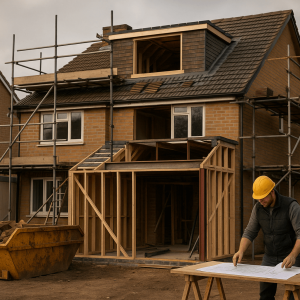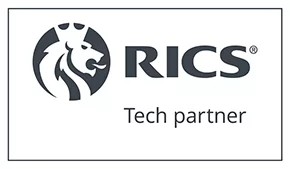Seal draughts, top up loft to ~300 mm, add smart controls; then insulate walls/floors and consider PV or a heat pump (some measures are 0% VAT in GB).
Energy costs bite hardest when homes leak heat. This guide prioritises the upgrades that cut bills fastest, then shows how to plan larger improvements (insulation, heat pumps, solar PV) the right way. If you want costs for a specific property, we can turn your drawings and scope into a line-item estimate you can act on, see Request a Custom Estimate. Helpful reads: Building Cost Estimator – UK, Construction Estimating – Guide, and RICS NRM – Complete Guide.
Executive Answer
Quick wins (days, not weeks): draught-proofing, loft top-up to ~270–300 mm, hot-water cylinder jackets, LED lighting, and smart heating controls typically pay back fastest. Next-level upgrades: cavity/solid wall insulation, underfloor insulation (suspended timber), solar PV (3–5 kWp), and modern heat pumps cut long-term costs and carbon best when combined with fabric improvements. Region: UK (Great Britain). Base date: Q4 2025. VAT stance: Costs below exclude VAT unless stated; many energy-saving installations qualify for 0% VAT in GB (check eligibility with your installer). Units: m², m, mm, kWp. Currency: GBP.
Table of Contents
- Where to Start (Priorities)
- Cost Summary
- Assumptions and Methodology
- Detailed Cost Breakdown
- Programme and Durations
- Regional Variation
- Inclusions and Exclusions
- Risks and Allowances
- Key Facts & Assumptions (At a Glance)
- FAQs
- Sources
Where to Start (Priorities)
Do the simple, fabric-first items before you buy kit. In most UK homes, the order below delivers the best £-per-kWh saved:
- Stop the leaks: draught-proof external doors, letterboxes, loft hatches; seal obvious gaps.
- Top up loft insulation to ~270–300 mm (and insulate/board a service walkway).
- Smart controls: a programmable thermostat, TRVs and zoning to match actual use.
- Hot water efficiency: insulate cylinder and primary pipework; set sensible temperatures.
- Lighting: switch to LED everywhere; consider sensors in low-use spaces.
- Wall and floor insulation: cavity fill where suitable; internal/external wall insulation on solid walls; insulate suspended timber floors.
- Low-carbon systems: right-sized heat pump (post-fabric upgrades), or hybrid strategies; add solar PV and consider battery if your usage pattern fits.
Cost Summary
Indicative ranges for typical UK homes at Q4 2025, ex VAT. Energy savings and payback depend on tariff, occupancy and usage.
- Draught-proofing: £80–£300 per door/house points; DIY or same-day fit.
- Loft insulation top-up (to ~300 mm): £12–£25 per m² supply & fit.
- Cavity wall insulation: £12–£22 per m² (subject to survey and suitability).
- Internal wall insulation (solid wall): £90–£150 per m²; External wall insulation: £120–£200 per m².
- Underfloor insulation (suspended timber): £30–£60 per m².
- Smart thermostat + TRVs: £180–£450 plus install.
- LED relamp: £3–£8 per lamp; whole-house £80–£250 depending on count.
- Air-source heat pump (incl. install): £7,000–£13,000 (system-dependent).
- Solar PV: £1,200–£1,700 per kWp installed (typical 3–5 kWp arrays).
- Battery storage: £500–£900 per kWh usable capacity.
Assumptions and Methodology
We follow a fabric-first approach aligned with UK guidance (insulation and airtightness first, then efficient systems). Costs combine materials, labour, preliminaries, OHP and typical risk allowances for domestic work. Ranges are conservative to reflect access, regional labour differences and specification choices. VAT varies: many energy-saving installations are 0% VAT in GB; confirm eligibility with your installer.
Detailed Cost Breakdown
Use this table to scope discussions and sanity-check quotes. Ranges are GB-wide, ex VAT, base date Q4 2025.
| Measure | Unit | Low £ | High £ | Typical £ | Base date | Notes |
|---|---|---|---|---|---|---|
| Draught-proof external door set | each | 80 | 180 | 120 | Q4 2025 | Brush seals, letterbox, threshold |
| Loft insulation top-up to ~300 mm | m² | 12 | 25 | 18 | Q4 2025 | Includes basic boarding walkway |
| Cavity wall insulation | m² | 12 | 22 | 18 | Q4 2025 | Subject to survey; vents maintained |
| Internal wall insulation (IWI) | m² | 90 | 150 | 120 | Q4 2025 | Plasterboard lining; service moves extra |
| External wall insulation (EWI) | m² | 120 | 200 | 160 | Q4 2025 | System finish affects cost |
| Underfloor insulation (suspended timber) | m² | 30 | 60 | 45 | Q4 2025 | Access via crawl space; airtightness taping |
| Smart thermostat + TRVs | set | 180 | 450 | 300 | Q4 2025 | Excludes complex zoning rewires |
| LED relamp (whole house) | house | 80 | 250 | 160 | Q4 2025 | Depends on lamp count/fittings |
| Air-source heat pump (ASHP) system | each | 7000 | 13000 | 10000 | Q4 2025 | Includes install; design & emitters vary |
| Solar PV array | kWp | 1200 | 1700 | 1450 | Q4 2025 | 3–5 kWp typical; roof/access dependent |
| Battery storage | kWh | 500 | 900 | 700 | Q4 2025 | Installer brand/warranty affects pricing |
Programme and Durations
- Draught-proofing & LEDs: same day.
- Loft top-up: 0.5–1 day (typical 40–60 m²).
- Cavity wall insulation: 0.5–1 day (subject to survey).
- IWI/EWI: several days to weeks depending on area and finishes.
- Underfloor insulation: 1–2 days for a room; whole-house varies with access.
- Solar PV: 1–2 days for 3–5 kWp; scaffolds add lead-time.
- ASHP: 2–5 days plus commissioning; emitter upgrades extend programme.
Regional Variation
Labour and access drive variation. London & the South East tend to higher ranges; rural installs can add travel and scaffolding costs. Roofing complexity, electrical upgrades and finishes also move the needle.
Inclusions and Exclusions
Included
- Materials, labour, preliminaries and typical installer OHP for domestic work.
- Basic making-good for insulation works; standard electrical connections for PV/controls.
Excluded (allow separately)
- Major re-wires, consumer unit upgrades, asbestos removal, complex scaffolds.
- Planning approvals or heritage consents; detailed design/coordination; structural works.
- Hidden defects revealed during works (e.g., damp remediation, timber repairs).
- VAT unless stated; check 0% VAT eligibility on energy-saving materials in GB.
Risks and Allowances
- Design & survey: allow for pre-install surveys (thermal/condensation risk for IWI/EWI; roof condition for PV).
- Price validity: components like inverters or heat pumps have limited quote windows—capture validity dates.
- Contingency: 5–10% on straightforward installs; 10–15% where access, fabric condition or electrics are uncertain.
- Inflation: apply from the base date to mid-point of works if lead-in is long.
Cost disclaimer: Ranges reflect typical GB domestic conditions at Q4 2025. Always confirm suitability and obtain written quotes aligned to your property and scope.
Key Facts & Assumptions (At a Glance)
- Fabric first: draughts, loft, controls before big-ticket systems.
- Indicative costs (ex VAT): loft £12–£25/m²; cavity £12–£22/m²; IWI £90–£150/m²; EWI £120–£200/m²; PV £1,200–£1,700/kWp; ASHP £7k–£13k.
- VAT: many energy-saving installs are 0% VAT in GB—ask your installer to apply where eligible.
- Programme: quick wins in a day; bigger fabric upgrades and systems take longer.
- Units & currency: m², m, mm, kWp; GBP; base date Q4 2025.
- Get a tailored plan: upload drawings to Request a Custom Estimate.
FAQs
What’s the best order to cut energy bills?
Start with draught-proofing, loft insulation and smart controls; then tackle wall/floor insulation; finish with PV and/or a right-sized heat pump.
Is external wall insulation better than internal?
EWI delivers whole-wall performance and reduces thermal bridges but costs more and changes the façade. IWI is less disruptive outside but needs careful moisture detailing.
How big should my solar PV system be?
Match array size to roof area, budget and daytime use. Many homes fit 3–5 kWp; batteries help if you have evening demand or want to use off-peak tariffs.
Can I get 0% VAT on energy-saving measures?
In Great Britain many qualifying energy-saving installations are zero-rated for VAT. Confirm eligibility and make sure your installer applies it correctly.
Do I need to upgrade radiators for a heat pump?
Often yes—heat pumps run at lower flow temperatures. A room-by-room heat-loss calculation will confirm emitter sizes and flow temps.
Who should install insulation or a heat pump?
Use accredited installers (e.g., TrustMark/MCS for low-carbon tech). Good surveys and commissioning are crucial for performance.
Next step: Want a property-specific upgrade plan with costs you can compare like-for-like? Request a Custom Estimate.
Sources
- HMRC – VAT on energy-saving materials (Notice 708/6)
- GOV.UK & Ofgem – home energy efficiency and grants (overview)
- TrustMark / MCS – accredited installers and standards
- Energy Saving Trust – consumer guidance on measures
- RICS NRM – structuring costs for clear comparisons











